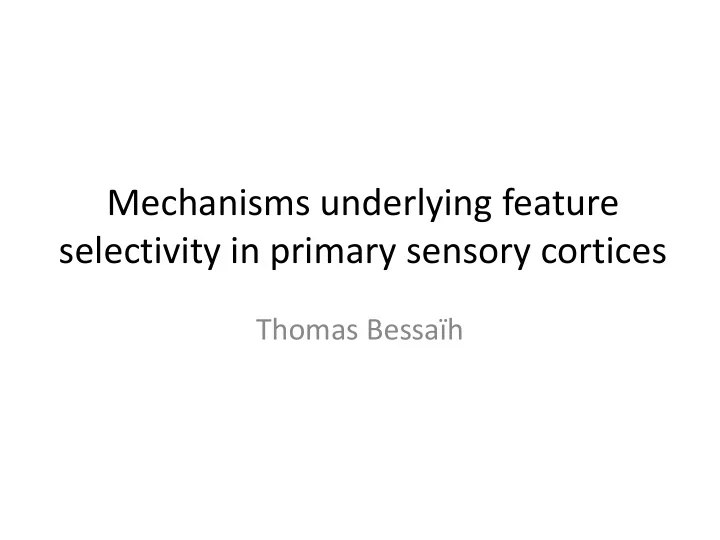

Mechanisms underlying feature selectivity in primary sensory cortices Thomas Bessaïh
In other to get access to the speaker’s comments, click on: Comments\show comments list
Kaniza Triangle
0 o A 90 o L 90 o R A L A R
pulvinar pretectum Optic radiation Post. commissure caudate LGN fornix Optic tract Medial geniculate
Six layers Why? Optic tract 1,2 = magnocellular (M); 3,4,5,6 = parvocellular (P) 1,4,6 = contralateral; 2,3,5 = ipsilateral ON and OFF cells separated in P layers (not M layers)
ON-center and OFF-center LGN cells
Retinotopic organization – “simple” but “distorted”
Anterograde transsynaptic degeneration due to loss of right eye
LGN receptive fields: same as in retina M cells (10%)– large, motion sensitive, no color selectivity P cells (80%) – small, center-surround, color selective In foveal representation the pathway is one to one: RGC LGN Layer IVC of area 17
Thalamic reticular nucleus (RNT) Waking state The gate is open
Sleep The gate is closed
pia • orientation selective • direction selective • stereoscopically sel. • just like LGN Mcell RFs white matter M-cells To extrastriate cortex (MT)
Orientation selectivity of cortical cells
M-cell pathway RGC LGN IVC α IVB Retina thalamus striate cortex On-center RF of cell in IVB Off-center RF of cell in IVB
Orientation selectivity IVCalpha IVB Hubel and Wiesel, 1962
The Feedforward Model of Orientation Selectivity in Primary Visual Cortex
Contrast Invariance of Orientation Tuning
Contrast Invariance of Orientation Tuning
Trial-to-Trial Response Variability and the Origin of Contrast- Invariant Orientation Tuning in Simple Cells
The Biophysical Mechanisms Underlying stimulus dependant changes in spike threshold of V1 Simple Cells I NA A NA
The Biophysical Mechanisms Underlying the Response Properties of V1 Simple Cells
Lateral connectivity! (similar to retina)
Reference RF Reference RF recorded at the asterisk doesn’t change #
c b a Kaniza Triangle
Schizophrenia and Visual Discrimination Normal Schiz 27 Spencer et al., Proc Nat Acad Sci. 101:17288-17293, 2004
Cat V1 Layer IV simple cell FF > 1.0
Precise but not Reliable but not reliable precise
Biophysical Limits? CNQX + APV + bicuculline Mainen and Sejnowski, 1995
Synaptic Limits? Lateral Geniculate Nucleus Reinagel and Reid, 2000
Stone et al., 1979
What about visual cortex?
What about visual cortex?
LGN Layer IV Push-Pull Excitatory Synapse Inhibitory Synapse (via interneuron, not shown) Bright Stimulus LGN Layer IV Push only Excitatory Synapse Bright Stimulus
A better stimulus: contrast modulated Gabor patch Optimization: Spatial location Spatial frequency Orientation Spatial Phase Length Width Jones and Palmer, 1987a,b,c
Methods • Extracellular recording in vivo, barbiturate anesthetized cat • LGN X- and Y-cells, Layer IV Simple cells in Area 17 (V1) • Contrast modulated Gabor patch optomized for each cell • Contrast drawn from Gaussian distribution (mean = 0, SD = 31%) at 125 Hz • Spike timing is acquired with a time resolution of 0.1 ms and spike times are rebinned using 1 ms bins (typically ISImin > 2 ms, therefore only 1 spike/bin).
Number of events X = 46 Y = 24 S = 50
Key question • How is the cortex able to maintain the precision of its principle inputs? The stimulus itself – produces synchronous activation of LGN cells
Similarity of LGN input across cells and cats LGN neurons of the same cell type respond similarly given the same Gabor patch sequence. Suggests: All LGN neurons located within a lobe of simple cell’s receptive field, respond 69% 77% 75% 69% similarly.
Similarity of LGN ON-NS/OFF-IS inputs to Cortex The responses of on-centered, LGN neurons are similar to the responses of off-centered, LGN neurons to inverted version of the same stimulus. 70% 75% Time (s) Time (s) Time (s) Suggests: Our stimulus synchronously activates all the LGN afferents of Layer IV simple cells.
Σ Σ
Summed ON-ns and OFF-is LGN Response Simple Cell Simple cells are as precise as any one of their inputs and more precise than the sum of their inputs.
Key questions • How is the cortex able to maintain the precision of its principle inputs? Cortical cells are sensitive to highly synchronous input from LGN afferents
Methods Excite two non-overlapping populations of LGN afferents at different times relative to each other. B A
Facilitation and Bar A suppresses Bar B suppression of the response
Intracellular recording (sharpies)
Intracellular recording (sharpies)
Supralinear for spikes but sublinear for EPSPs Can be explained by the accelerating non-linearity in the spike generating mechanism (Reid, et al., 1987; DeAngelis et al., 1993a,b; Anzai et al., 1999; Carandini & Ferster, 2000; Nykamp & Ringach, 2002)
• LGN X and Y cells and cortical simple cells have highly stereotyped responses to stimuli containing rapid transients • Simple cells are as precise as any one of their LGN X-cell inputs and more precise than their putative pooled input • Membrane potential in simple cells follows the pooled LGN input closely • Biophysical mechanisms related largely to the spike generation in simple cells render the response to synchronized thalamic input larger and more precise than expected • The stimulus… • Coincidence detection……
Recommend
More recommend